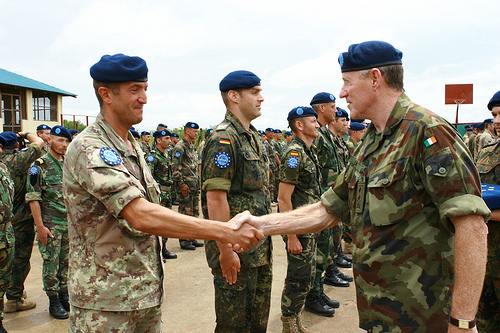
The debate about European defense tends to focus on the need to spend more and deploy more. One deceptively simple question is usually ignored: why? Americans seem to assume that more European capabilities will be deployed where it is convenient for the United States. Europeans just seek to avoid the difficult debate that it would provoke – until now.
In December 2013 the heads of state and government of the European Union (EU) will discuss defense. At the instigation of European Council President Herman Van Rompuy they are likely to address this eminently political question too. Which role does Europe aspire to as a security provider outside its own borders?
Europe, not the EU’s Common Security and Defense Policy (CSDP). At the 2013 annual conference of the European Defense Agency, Van Rompuy clearly expressed his concern to be not just the CSDP but “the state of defense in Europe.” The strategic debate cannot be limited to some aspects likely to be acted upon through the CSDP. The challenge is to define overall priorities for the use of the military instrument, in function of the vital interests and the foreign policy of the EU and its member states. The logical political forum to set such a European military strategy is the EU, but without any prejudice to action under UN, NATO, CSDP, or national command–the crisis will determine that choice in each individual case.
The regions and contingencies in which their vital interests are most directly threatened determine the responsibilities that Europeans should assume and be willing to act upon. In (1) crisis management, they must be able to act across the full spectrum of expeditionary operations, up to peace enforcement and war. But a military strategy also encompasses (2) prevention, by maintaining a permanent forward presence in priority areas, and (3) deterrence, by having a credible power projection capacity at all times.
Austerity budgets render prioritization even more important: strategy is crucial to assure that what means we do have are spent in the most relevant way. The shift of the American strategic focus to Asia is another major factor. The “pivot” does not determine what European priorities are, but in limiting the extent to which American capabilities can be counted upon it does determine how many European capabilities will be required.
Three priority responsibilities then emerge:
- Taking the lead in assuring peace and security in Europe’s “broader neighborhood”, extending into the Sahel, the Horn of Africa and the Gulf. While the United States will undoubtedly continue to play a role, Europeans will increasingly define the strategic and operational priorities in this broad region. They must be able to mount major operations in response to war within or between states, preferably in coalition, but on their own if necessary.
- Contributing to global maritime security: a major challenge, in view of Europe’s dependence on seaborne trade, and the fact that maritime issues are rarely solved on sea only, as the Somali piracy problem has demonstrated.
- Contributing to the collective security system of the UN: Europeans need an effective UN in case of crisis in their own near abroad and have a responsibility therefore to contribute to its effectiveness worldwide.
Strategic priorities should then be translated into a level of ambition: how many capabilities must Europeans devote to them?
- A permanent strategic reserve: the ability to mount a decisive air campaign and to deploy up to an army corps, as a single force if necessary, for combat operations in Europe’s broader neighbourhood, over and above all on-going operations. This de facto “double Headline Goal” (the EU’s original 1999 objective of deploying up to 60,000 troops) reflects the rate of deployment of the last decade. Europeans did permanently deploy 60,000 or more–but could not have dealt with an additional major crisis.
- Maritime power: the ability to achieve command of the sea in the broader neighbourhood, while maintaining a global naval presence in order to permanently engage with partners (through joint patrolling e.g.), notably in Asia and the Arctic.
- Regional strategic autonomy: acquiring all strategic enablers, including air and maritime transport, air-to-air refuelling, and ISTAR, to allow for major army, air and naval operations in the broader neighbourhood without reliance on American assets.
- Strategic planning: the capacity, within the European External Action Service, to engage in permanent contingency planning incorporating all available civilian and military instruments, and to liaise with any military headquarters conducting an intervention.
Strategy has to drive the acquisition of the means, but also decision-making. When the next crisis arises, decision-making should be faster, and mandating action by the able and willing Europeans under the political aegis of the EU should be easier. Thus a truly comprehensive approach, integrating operations under whichever command structure the able and willing have recourse to with the entire toolbox of the EU, should become reality.
Europeans may shortly withdraw from Afghanistan, but on-going and looming commitments will not allow them to withdraw from the world.
Prof. Dr. Sven Biscop, a member of the Atlantic Council’s Strategic Advisors Group, is director of Egmont’s Europe in the World programme and teaches at Ghent University and the College of Europe. This essay is adapted from a longer Security Policy Brief just published by Egmont.
Photo credit: European External Action Service
Image: 8070155161_ca3265c6c3.jpg
